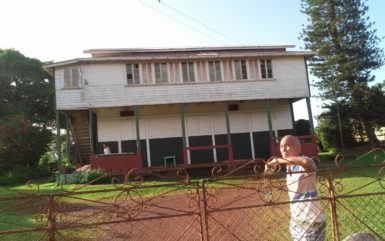The name Chan-A-Sue is commonplace at Mabaruma. Inquiries as to how to get a sense of what the community was all about led to 72-year-old Godfrey Chan-A-Sue. He was born at Mabaruma as were his parents Emanuel and Katherine.
In 1988, after spending more than a quarter of a century away from home working in the city, he returned to Mabaruma to assume control of the family business, Chan-A-Sue Trading, a groceries and hardware outlet situated at Chan-A-Sue junction in Mabaruma.
Chan-A-Sue junction sits on a portion of 200 acres of land which has been in the family since 1930. Time was when Godfrey’s grandfather and father cultivated oranges, grapefruits and avocadoes and shipped them to Georgetown. Godfrey remembers that the boat would arrive at Mabaruma fortnightly to move the fruit. In those days, in the absence of agro processing facilities there was considerable wastage. Citrus production at Mabaruma, Chan-A-Sue says, has become crippled. These days there is lingering evidence of times past manifested in a handful of orange and avocado trees. Twenty cows, 70 sheep and more than 70 ducks have plenty of land to live on.

There is, Godfrey says, a market for beef at Mabaruma. He sells cows to the butchers. Sheep and ducks have a more modest market. One gets the impression that Godfrey’s persistence with sheep and ducks derives largely from habit.
Before he returned to Mabaruma, Godfrey worked for the Texaco West Indian Company. He began his career there as a junior clerk and subsequently occupied various accounting and auditing positions. Upward mobility meant access to several overseas courses in the Caribbean, the United States and Canada. Eventually he became part of the company’s management team. His decision to leave Texaco and return to Mabaruma in 1988 was driven largely by the fact that his parents were ‘getting down.’
Back home he created The Scorpion Club, a facility to cater to the recreational needs of public officials stationed at Mabaruma. He recalls that the club afforded opportunity for like minds to discuss topical issues as well as to indulge in card and board games. Godfrey also served as the non-salaried project manager for the construction of the North West Secondary School, as well as on the project associated with the extension of the Mabaruma Hospital.
These days, Godfrey’s primary preoccupation is with the daily running of Chan-A-Sue Trading. It is a modest operation compared to the newer trading establishments and increased competition and a modest market means that business is not exactly booming. The groceries and hardware offered by Chan-A-Sue Trading can be had at other outlets at Mabaruma. The rest of his working time is spent tending his farm animals with the support of a helper.
When you ask Godfrey about the commercial environment at Mabaruma he responds simply that “business is dead.” It is a pronouncement that requires an explanation and you find yourself waiting for it. Several years ago Mabaruma used to supply coastal Guyana with significant quantities of vegetables and ground provision. Transportation limitations and coastal competition have closed that door.
He reflects on the kind of step-start development that Mabaruma has experienced as reflected in the various “failed projects” like the proposed hydroelectricity project at the Hosororo Falls, the empoldering project at Morawhanna to remedy the flooding problem there and the cocoa project at Wauna. These failures, Godfrey believes, can be attributed to administrative inadequacies. He contemplates what he says has amounted to a waste of good money and time. At the site of the cocoa project there are solar panels which continue to supply a private business with power.
Business in Mabaruma, he says, is affected by a highly unreliable river transport regime. Notice of vessels departing for the North West is often perilously short so that by the time consignments arrive for some businesses the travelling vessel is already filled. Godfrey says he has read about the eventual introduction on the route of a new vessel currently being built in India. He is hoping that the authorities will undertake a hydrographic survey of the river to collect data that will help inform the design of the vessel.
Godfrey is concerned that hinterland development is being taken seriously. The interior, he says, is being neglected and there may be question marks against the knowledge of some of those assigned to undertake important projects. All of that has to change if hinterland communities are to be better positioned to deliver on the expectations of central government.




